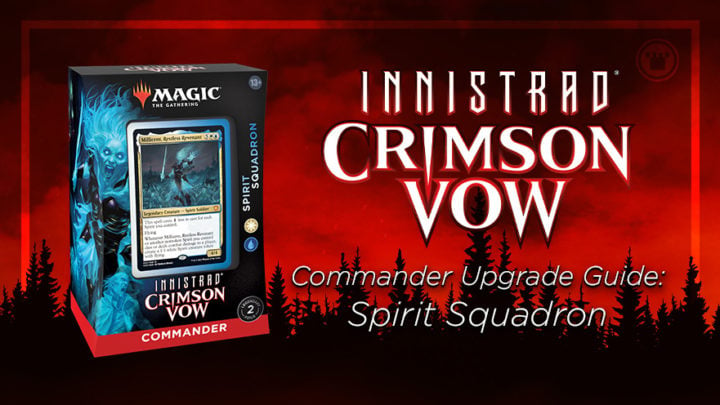Innistrad: Crimson Vow has been live on Arena since Thursday, and you’ll be able to pick up packs and singles very soon. This is the second part of our return to the horror plane of Innistrad, and unlike Midnight Hunt, it’s all about Vampires, Spirits, and the marriage between Olivia Voldaren and the newly resurrected Edgar Markov. To reflect this, the Commander preconstructed decks are helmed by brand new legendary creatures: one Vampire, and one Spirit. Both creature types are extremely popular, so it’s no surprise that they are proving to be a hit with players!
Today, I’ll be taking a look at the Spirit Squadron deck, which looks to amass a board of threatening Spirits and close out the game with an impressive flying army.
New Commander Cards
Crimson Vow maintains the recent trend of preconstructed decks being full of brand new cards, with Spirit Squadron containing 15 new additions to the Commander format. As a number of them are designed to benefit Spirits specifically, some of the new cards can be quite limited in their application in other non-Spirit decks; however, they make up for that by being quite powerful. Here’s a breakdown of the most important new cards in this deck:
Millicent, Restless Revenant is one of the few viable Spirit commanders available, and possibly the strongest. Hofri Ghostforge lacks access to any of the powerful blue spirits, and Ranar, the Ever-Watchful doesn’t do enough to benefit the creature type by himself. Millicent, however, costs less for each Spirit you control, and provides you with additional Spirits to either snowball out of control or have insurance against board wipes.
In order to wipe the board effectively, your opponents have to remove Millicent before destroying other creatures, lest she reimburse you with another small army. This level of resistance to mass removal is very rare, and the ability to advance your board state when you’re ahead makes Millicent an exceptionally flexible commander.
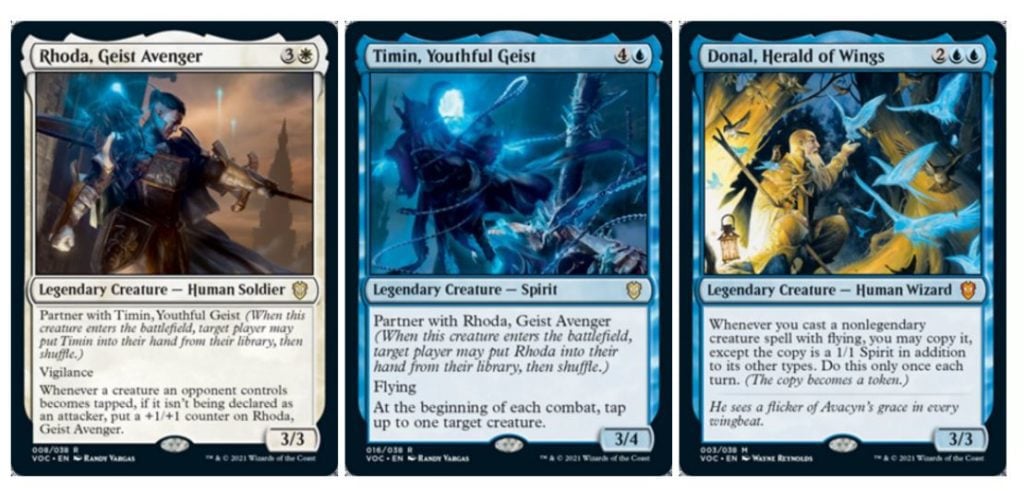
The secondary commanders for the deck come in the form of a new pair of partners: Rhoda, Geist Avenger, and Timin, Youthful Geist. Their mechanics are very clever — Timin distracts an enemy, giving Rhoda the opportunity to strike. They don’t really synergize with the rest of the deck, apart from Timin being a Spirit, but they would make for a very interesting pair in the command zone. A blue-white deck that looks to control combat through tapping down creatures is something we haven’t seen before, and it could make for a great casual deck.
Donal, Herald of Wings (an Irish name, pronounced “dough-nul”) is a bizarre creature. His ability is unlike any other; copying flying creatures as 1/1 Spirits is a great effect, and it can be used to great effect with enter the battlefield triggers. He’d make for a great addition to the 99 of flyers decks, or as the commander of a unique mono-blue list. I look forward to casting a Peregrine Drake in his presence!
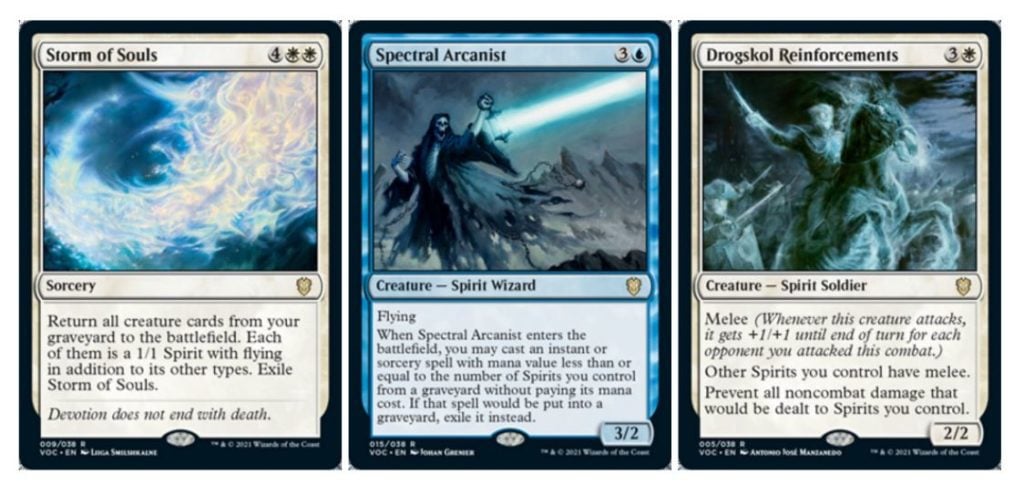
White is getting access to mass reanimation, and it’s pretty sweet. Storm of Souls isn’t quite Rise of the Dark Realms, but it’s still very powerful! Six mana is still a great rate to bring back three or four creatures, for example, especially if they have good enter the battlefield abilities. The reduced power and toughness may not be ideal, but the good far outweighs the bad here.
Spirits are also getting their own Torrential Gearhulk! Well, sort of. Spectral Arcanist lets you play an instant or sorcery from the graveyard, provided you have enough Spirits on board. It may not be as universally useful as a Gearhulk or Snapcaster, but it can still provide good value and utility. A lack of flash is a huge stroke against it, however, though being able to protect against a board wipe at instant speed would probably be a little too pushed for the deck.
Drogskol Reinforcements is an incredibly powerful board-wide boost that incentivizes attacking everyone together. Melee is well balanced in that the buff isn’t permanent, making the team more susceptible to damage-based sweepers. The payoff is well worth it, however; an extra three power per creature is no joke, and can easily end games out of nowhere.
Spirit Squadron Deck Review
Similar to Spirits decks in other formats like Modern or Pioneer, Spirit Squadron is an aggressive deck with evasive threats and disruptive spells. The plan is to keep opponents on the back foot just long enough to win the game. This rings true here, too; the deck’s curve is relatively low, with an average mana value of 3.32, and there’s a whopping 34 creatures in the 99 (20 of which cost three mana or less). There are also a number of cards that generate tokens, either on resolution or when other creatures die. These help get Millicent on board early and often, which is fairly important to getting the most out of your creatures. They do feel like they’re not quite as effective as other cards could be in their slots, especially considering that tokens don’t trigger Millicent’s second ability, but they serve well enough as is. There’s also a subtheme of creature tapping, evident on some of the cards in the 99. It feels like a very modest strategy in Commander, as it won’t really have an impact in a game with three other battlefields to contend with.
The value you get in the 99 is good considering the price tag, though it is a bit lower compared to previous offerings. The staples that we have come to expect from every precon are there — like Sol Ring, Arcane Signet, and Azorius Signet — as well as a few color-relevant classics, like Swords to Plowshares and Ghostly Prison. The main value comes from the new cards, but even most of them are around $2-3. There are no high-value reprints this time round; there have been one or two decent reprints in every preconstructed deck so far this year, so this is a slight break from the norm. It would have been the perfect place to get a Selfless Spirit or Skyclave Apparition reprint, considering how on-theme they are.
The total cost of the deck as singles is $68 at time of writing. This is not particularly high, and is, in fact, the lowest of all precons that I’ve reviewed this year. It’s still above the deck price of $34.99, but it’s mostly a wise investment if you’re interested in building a Spirits deck, rather than something to keep sealed for the future.
As for power level, the deck performs above its price tag. I’d put it on par with the Midnight Hunt preconstructed decks, and it plays fairly well. The aforementioned low mana curve and mana reduction attached to Millicent really put in the work to make this a relatively smooth deck to play with. Wizards have gotten pretty good at balancing all the recent preconstructed decks to play well together, so I wouldn’t be too concerned if you wanted to play this against other precons from the past year or so.
Upgrading Spirit Squadron
As I’ve mentioned already, the deck is fine as is, and plays as well as you would expect from a preconstructed deck. There are no massive problems, though there are some cards that don’t fit the game plan.
First of all, the tapping mechanic that shows up on some cards could probably be replaced with more effective and flexible choices. Next, there are three sweepers that obliterate your own board as well as the opponents. Millicent may give you value for each board wipe, but it’s still a creature-heavy deck; you would rather not lose the board presence you worked so hard to build up! Finally, while token-generation may power Millicent out quicker, tokens don’t work with her second ability. If some of these were replaced with actual Spirit cards, they would provide more tangible advantage while still discounting your commander.
The main focal points for this upgrade will be:
- Add more Spirits
- Improve disruption
- Increase the deck’s clock
Anything that doesn’t compliment either the main game plan or bolster any of the pillars of the upgrade will be replaced by something better suited.
Spirits
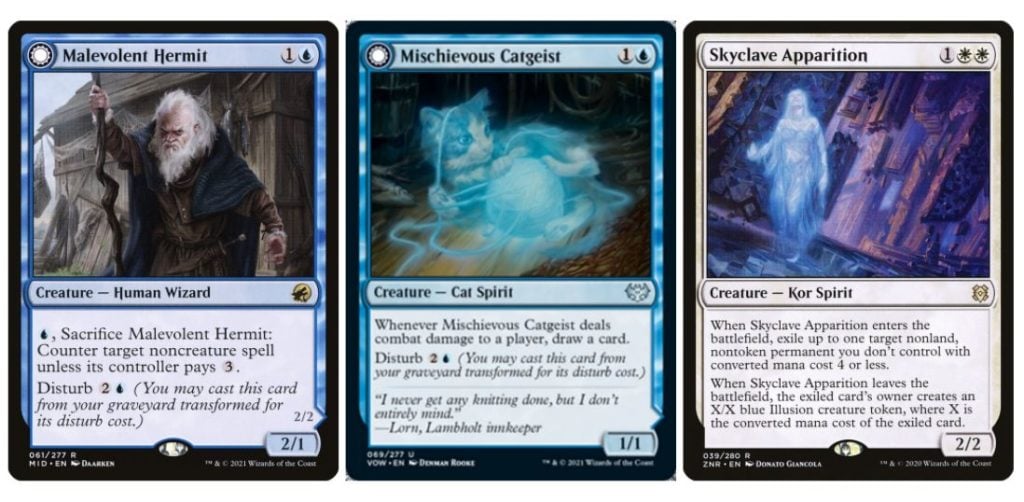
One of the strongest aspects of Millicent, Restless Revenant is that she gives you a Spirit token whenever a nontoken Spirit dies or deals combat damage. There are a number of great Spirits that you can add to the deck to really make use of that ability, all while providing extra value individually!
Malevolent Hermit isn’t technically a Spirit (yet), but it’s great to get on board early and dissuade opponents from playing important noncreature spells. Once you bring it back for its disturb cost, the newly transformed Spirit can ensure that your removal and protection spells always resolve.
Who said Spirits can’t be adorable? Mischievous Catgeist may lack evasion by itself, but its built-in Curiosity effect is worth a slot in the deck. Even if it only connects once, it will have done its job. Once you disturb it, you can enchant one of your many flying threats to keep the cards flowing.
Hailed as one of the best removal spells printed in the past few years, Skyclave Apparition is the perfect addition to the deck. Not only is it a Spirit, but it can deal with 86 of the top 100 most played cards in Commander (according to EDHREC), and 54% of all commanders ever printed! They’re impressive numbers that would be enough to give Skyclave Apparition a home, even non-Spirit decks.
Improved Disruption
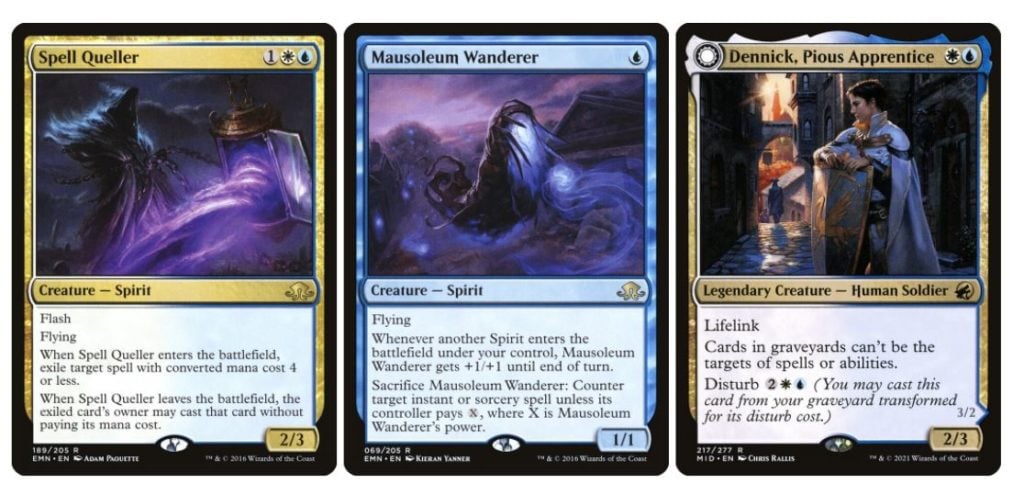
When you’re committing so heavily to the board, you’ll want to protect your investment. Some of the best ways to do that is through disruption, whether that’s countering spells or shutting off your opponents’ options.
Spell Queller is the card I most expected to see in the preconstructed deck, and I’m shocked it didn’t make it into the 99. It’s perfect for dealing with Wrath of God or even Supreme Verdict, it’s cheap, and it can attack! This is the ideal tempo piece for the strategy and one of the best additions to the deck.
Mausoleum Wanderer is as cheap as can be, and it performs well above its mana cost. For a single mana, you get an evasive threat that can stop critical spells at the right time. If your opponents remember that it’s on board, that’s even better; they won’t want to overextend and play an important instant or sorcery with this Spirit threatening to take care of it.
Like Malevolent Hermit, Dennick, Pious Apprentice is another honorary Spirit. His main goal is to lock down some graveyard shenanigans while you get to work lowering your opponents’ life totals. It’s not intended to shut them out completely, but it’s enough of a roadblock to help you keep them in check. The reverse side, Dennick, Pious Apparition, is another evasive threat that can give you some extra value to keep up with opponents.
Increased Closing Power

As this is a creature deck, it’s important to be able to close the game in short order, lest the slower value machines of the format overwhelm your floating friends. Board-wide buffs are key to achieving this; the deck already contains Drogskol Captain, Supreme Phantom, and Drogskol Reinforcements, but a few extra options will increase consistency and redundancy.
Patrician Geist is another board-wide lord effect that will have a huge impact on the board. It will give your team a respectable boost of an extra point of power and toughness, and it even discounts your disturb spells when they’re in the graveyard.
Makindi Stampede may be a five-mana sorcery, but its utility makes it a shoe-in for any white creature-heavy deck. The opportunity cost is extremely low, and it can produce surprise wins when opponents aren’t prepared. It’s not the best land, nor is it the best pump spell, but it’s far greater than the sum of its parts.
If going wide doesn’t appeal to you, or if an opponent has a Ghostly Prison-like effect, Katilda, Dawnhart Martyr is the Warlock for the job. In this deck, she becomes enormous as you continue your usual game plan, and she’s a great payoff for committing creatures to play. Lifelink is also critical when you’re attacking most turns; smart opponents will try to race you if they see the opportunity, but Katilda will ensure you stay out of danger range. You can also disturb her and turn Millicent into a surprise Voltron kill, which will really take opponents by surprise!
Additional Upgrades
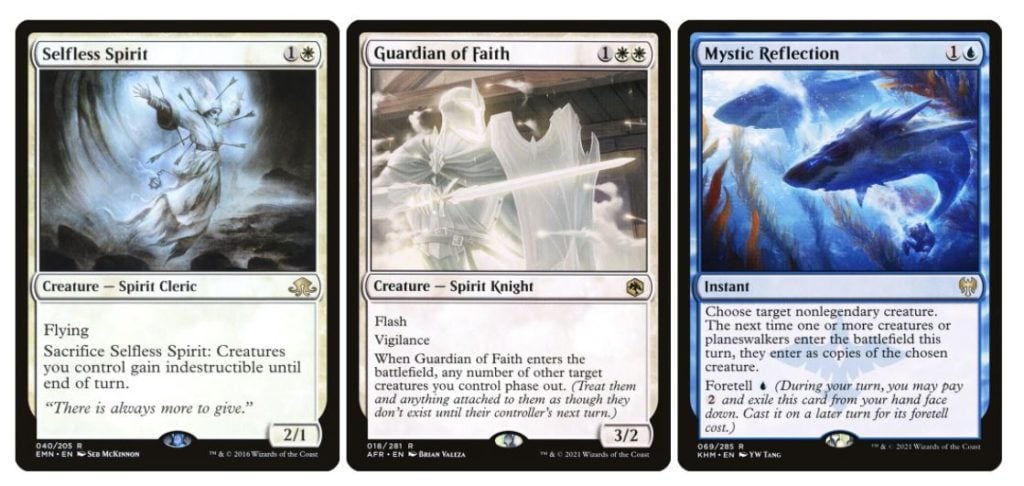
While Millicent is exceptional at preventing you from falling behind from a board wipe, there are a number of thematically appropriate options to protect you even further.
Selfless Spirit needs no explanation, really. I was shocked that it wasn’t included in the precon, and it’s an easy and important upgrade. A board-wide protection spell that can also attack is exactly what this deck needs, and Selfless Spirit is the best of the bunch.
One card that doesn’t see enough play yet is Guardian of Faith. Its phasing ability can keep your entire board intact, whether you’re blocking or responding to a board wipe. It’s also a Spirit, which further feeds into the main synergies in the deck. A little trick with this card: if your opponent overloads a Cyclonic Rift, you can flash Guardian of Faith in to phase out your team and keep them in place. The Rift will return Guardian of Faith to your hand to protect the team again on another turn!
While Mystic Reflection doesn’t protect the board per se, it does give you a lot of chaotic utility. If you have Millicent and a Supreme Phantom on board, for example, you can target the lord with this, meaning the tokens you’d get from your commander will be Spirit lords instead! That can often be much worse for your opponents than simply protecting your current board. Another trick is to target one of your tokens with an opponent’s Avenger of Zendikar on the stack, giving them a seven-mana 1/1 flyer instead of the expected Elemental.
The Full Upgrade
Check out the full decklist here!
Below is a list of all of the cards I removed, and the full list of upgrades I added to the deck. As I explained earlier, anything that doesn’t directly enhance the primary game plan was replaced with something more suitable. Some cards, like Oyobi, Who Split the Heavens, are too inefficient for most tables, and cards like Kirtar’s Wrath can be actively harmful towards your game plan.
Cards Added
- Ash Barrens
- Austere Command
- Bident of Thassa
- Dennick, Pious Apprentice
- Generous Gift
- Guardian of Faith
- Kabira Takedown
- Katilda, Dawnhart Martyr
- Kira, Great Glass-Spinner
- Makindi Stampede
- Malevolent Hermit
- Mausoleum Wanderer
- Mind Stone
- Mischievous Catgeist
- Mystic Reflection
- Nimbus Maze
- Patrician Geist
- Selfless Spirit
- Skyclave Apparition
- Spell Queller
Cards Removed
- Angel of Flight Alabaster
- Azorius Chancery
- Azorius Locket
- Breath of the Sleepless
- Disorder in the Court
- Fell the Mighty
- Flood of Tears
- Geist of Saint Traft
- Ghostly Prison
- Kami of the Crescent Moon
- Kirtar’s Wrath
- Nebelgast Herald
- Oyobi, Who Split the Heavens
- Promise of Bunrei
- Rhoda, Geist Avenger
- Shacklegeist
- Sire of the Storm
- Temple of the False God
- Timin, Youthful Geist
- Verity Circle
The total cost of this upgrade is roughly $60. This is the sweet spot in Commander to me: the power-to-dollar ratio is at its highest around this price point, and can be easily tweaked to increase or decrease in power as you see fit. If you like this deck, you can buy all the singles at the same time as the preconstructed deck, saving you time as well as money.
Whether you buy the full upgrade, just the preconstructed deck, or some unique upgrades of your own, be sure to show off your awesome new cards to us on Twitter!

Scott is an Irish content creator and the Head of Budget Magic for the Izzet League. He focuses on affordable decks in Pioneer, Modern, and Pauper, particularly ones that stray from the mainstream. When he’s not writing about his favorite decks, he can be found talking incessantly about them on Twitter and on The Budget Magic Cast.

